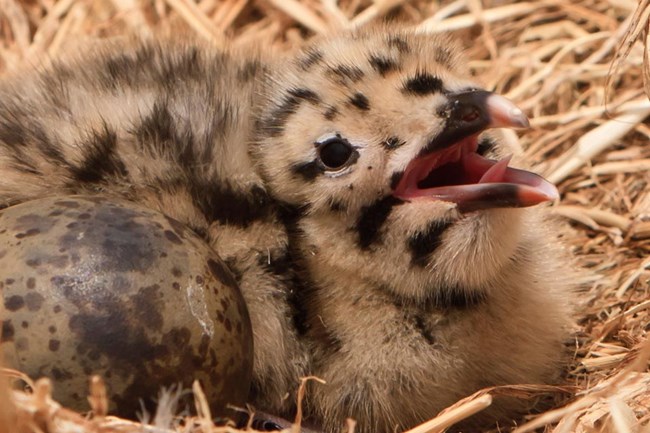
Anacapa Island provides critically important habitat for seabirds, pinnipeds, and endemic plants and animals. The island's steep, lava rock cliffs have numerous caves and crevices that are particularly important for the increasingly rare seabird species, Scripps's murrelet and ashy storm-petrel. The largest breeding colony of the California brown pelican in the United States is Anacapa Island and a unique subspecies of deer mouse occurs only here as well. The Anacapa ecosystem, however, was degraded by the presence of non-native black rats (Rattus rattus). Rats have been introduced to over 80% of the world's islands, accounting for an estimated 40-60% of all bird and reptile extinctions in the world. On Anacapa, rats were introduced prior to 1940, most likely as stowaways on ships to the island. They have had large impacts on nesting seabirds, preying heavily on eggs and chicks of seabirds as their food source. Approximately 40% of Scripps's Murrelet nests on Anacapa have shown evidence of egg predation. Rats also prey directly on the native island deer mouse. In the mid-1990s, the park teamed with the Island Conservation and Ecology Group (ICEG) to determine if and how rats could be eradicated from Anacapa Island. ICEG, active internationally in the restoration of island ecosystems through the eradication of non-native species, was aware of several successful eradications of rats from islands, particularly in New Zealand. Rats have been eradicated on over 100 islands worldwide by applying rodenticide bait; trapping alone has never succeeded. Anacapa Island presented special challenges. The island has extensive steep cliffs, making placement of bait into the territory of every rat difficult. The endemic deer mice would feed on any bait that was attractive to rats. The endangered California brown pelican, extremely sensitive to disturbance, breed and nest on a large portion of the island during eight months of the year. Following extensive consultation with experts, the park and ICEG determined that rats could be eradicated through the distribution of bait pellets with brodifacoum, the anticoagulant used in the majority of successful rat eradications. This product contains half the amount of rodenticide that is found in products that homeowners commonly purchase in the local grocery store and it would not accumulate in the environment since it breaks down into harmless carbon dioxide in water. Fortuitously, the American Trader Trustee Council (ATTC), consisting of California Department of Fish & Game, National Oceanic and Atmospheric Administration, and the U.S. Fish & Wildlife Service, had court settlement monies resulting from an oil spill in southern California. The purpose, in part, of the settlement monies was to restore seabird populations injured by the oil spill. The trustees supported eradication of the black rat from Anacapa Island because it is one of the most significant islands for breeding seabirds in southern California. The bait application (from a hopper suspended under a helicopter) was scheduled during the fall, the end of the dry season, when rats were very hungry and both visitation and bird populations were low. Protection of the native deer mice had two components: a) holding a small population of mice in captivity, and b) maintaining deer mice in the wild by treating East Anacapa one year prior to treating Middle and West Anacapa. Phase I, application of bait to East Anacapa Island, was completed in December 2001 and Phase II, treatment of Middle and West Anacapa, was completed in fall 2002. Extensive ecological monitoring pre- and post-rat eradication was conducted to determine the environmental impacts of the project. This monitoring has found substantial recovery of rare seabirds and other native wildlife on Anacapa Island following the eradication of rats. Mouse populations have returned to normal and they are breeding abundantly in the wild, while juvenile side-blotched lizards and slender salamanders are thriving in the absence of rats. Numerous environmental groups endorsed the project including the American Bird Conservancy, Pacific Seabird Group, California Audubon Society, Endangered Species Recovery Council, Audubon Living Oceans, and Jean-Michel Cousteau's Ocean Futures. American Bird Conservancy President, George H. Fenwick, stated, "The Anacapa Island project is precisely the type of well-designed, extensively researched, and responsibly implemented program that the American Bird Conservancy supports and encourages. The long-term benefits of rat eradication on Anacapa Island are enormous for the conservation of one of North America's most distinctive ecosystems." Almost immediatly, scientists recorded a dramatic and positive response by Scripps's murrelets, a rare seabird that nests on the island. In 2003, Thomas Hamer, of Hamer Environmental, reported, "We have detected increases in the number of birds visiting nesting colonies ranging from 58% to more than two times higher when compared to the number of detections that we recorded per night in any of the previous years." Since then, biologists have continued to monitor an increasing number of nests of Scripps's murrelets and a consistently high success rate for hatching of eggs. Another rare seabird, Cassin's auklet, has returned to Anacapa Island as a breeding following the elimination of the rats. They continue to be very uncommon on the island. It is hoped that their numbers will also continue to increase. Channel Islands National Park Superintendent Russell Galipeau, comments, "This project was critical to protecting and restoring the rare and unique wildlife on Anacapa. The National Park Service is dedicated to ensuring a diverse, naturally functioning island ecosystem."
Visit our keyboard shortcuts docs for details
Documents the removal of non-native species on Anacapa Island.
Visit our keyboard shortcuts docs for details
Ten years after removing nonnative rats the ecosystem on Anacapa Island, including rare seabirds, is showing profound results of recovery. |
Last updated: December 13, 2022
